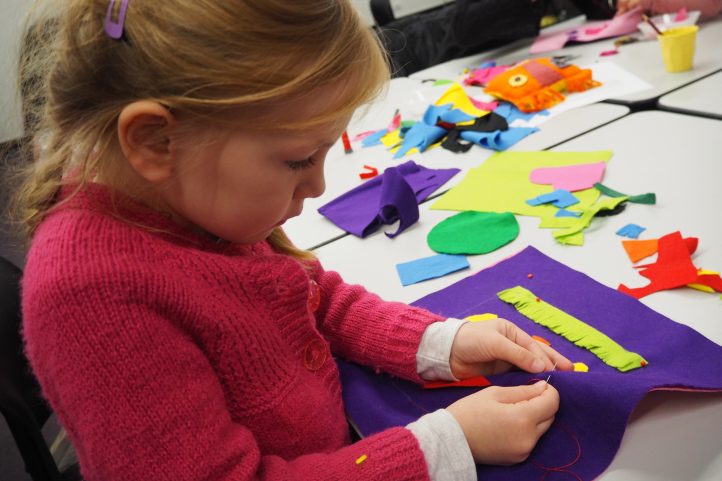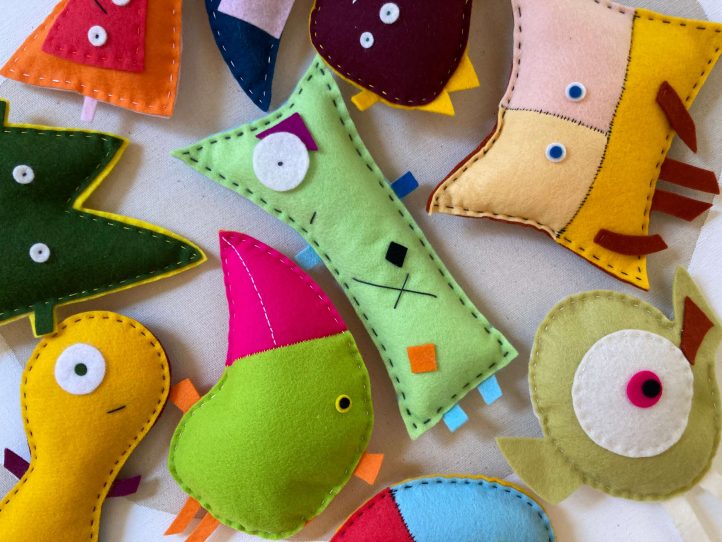
Photo provided by designer.
Over the years, since I founded Sew a Softie, I’ve learned that there are a lot of grandmothers who want to sew with their grandkids. I’ve seen how thrilled they are when everything works. One grandmother was even sewing with her granddaughter 21st century style over Zoom! But I often receive emails and texts telling me how things didn’t run smoothly and seeking advice. Many discover that, despite being competent sewers themselves, teaching young kids can be… well… challenging.
In this article, I will look at how to recognize suitable projects for young first-time sewers, how to make sewing with our grandkids run smoothly, and the role that we need to play to make sewing a fun, rewarding experience for them.
Choosing a Project
First, a suitable project for young kids must be simple enough for them to complete within a short time. This means it shouldn’t involve too many pieces or fiddly techniques. Kids want to see a finished result. They love feeling like, “Wow! Look what I made!”
And they don’t want to wait!
Second, choose a suitable fabric. Avoid fabrics that are difficult to handle. Felt is fantastic for kids. It’s soft, colorful, doesn’t fray (which means you don’t have to turn your project right side out), is widely available and economic. Be mindful, however, that felts vary in quality. A good felt should not feel hard or scratchy and certainly shouldn’t tear.
Third, projects for kids should be fun and creative so they can use their wonderful imaginations. This allows them to put themselves into a project, which means they will enjoy their sewing immensely and want to come back for more.
In 2015, I was trying to create a sewing project that ticked all these boxes. I came up with a softie/stuffie design I called a zenki.
Zenki-style softies can be made from just two pieces of felt, and they require no fiddly insertions for arms, legs, wings or whatever protruding bits kids can dream up. A zenki can be completed within an hour and the only stitch you really need is a running stitch. You can find free tutorials on how to teach a running stitch to young kids on my YouTube channel and plenty of free zenki projects at my Sew a Softie website (You can find the links for Trixi’s site and social media in her bio). They should help you find your feet and get started and they should give you a good idea of what “simple” means when we’re dealing with young first-time sewers.

Photo provided by designer.
How to Make Sewing Run Smoothly
Needles are important. Large blunt needles for kids are not helpful. They are hard to push through fabric and make sewing a chore. Small needles are perfect for small hands and 30 years of teaching has taught me that when kids are trusted with an adult tool, they are keen to show how sensible they are.
Typically, kids will find threading the eye of their needle a challenge. Many thrive on this challenge but using chenille needles, which have large, elongated eyes, is a great help. You can also solve the threading problem by using a needle threader. Kids absolutely adore them. And you can make one very simply from a small piece of paper. Again, if you want to learn how, I have a free tutorial on my YouTube channel.
Good quality thread is also important. Thread that breaks while sewing makes for frustration. I like ordinary sewing thread as it’s thin enough to double over and knot. This stops it slipping off needles. I use a double stitch to start a line of sewing. This secures the thread and stops kids from pulling their knot through the fabric. Also, drawing a sewing line onto the fabric can keep kids on track. Soft lead pencils work on light felts. On dark colored felts, you’ll need white wax pencils.
With a running stitch, I get kids to think of the tip of their needle as a dolphin, diving into the ocean and jumping back out. It’s a simple way to make a running stitch easy for kids to master.
The Role We Need to Play
When sewing with kids, we’re not there to make sure their project is perfect. Kids don’t want perfect. And they don’t want us to do their work. That makes them feel like, “I can’t do this! I’m not good enough!” And yes, sometimes kids really believe they need us to tell them what they should choose or to sew stitches for them. They believe this because they’re afraid they’ll do it all wrong or make a mistake. Our role is to reverse this belief.
If we do their work for them, we smother the growth of their budding self-confidence. Our role is to enable their choices and work, not to make their choices or do their work. Our role is to help them to be able to feel like, “Wow! Look what I made! How good am I!” Recently, a grandmother told me she saw herself as just a “consultant”. When her granddaughter got stuck and couldn’t go on, she was there to support and advise. That’s our role.
We can do all the things I’ve talked about in this article: We can choose a project that’s suitable, fun and creative, we can have all the technical bits running smoothly, but if we want our grandkids to come back for more, we have to get our role right.
Happy sewing, Trixi
